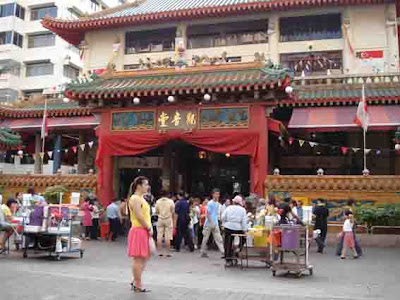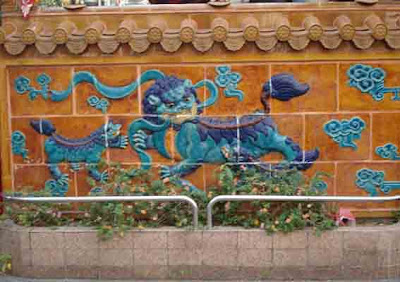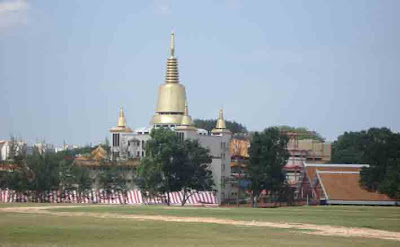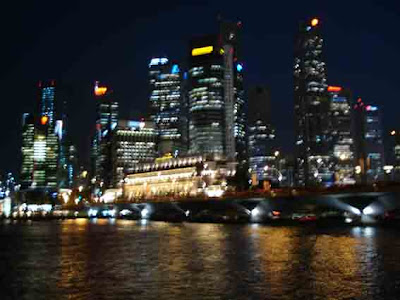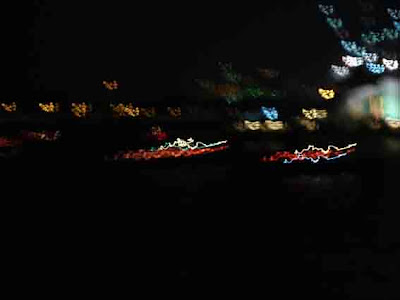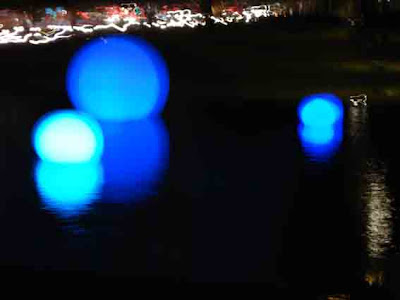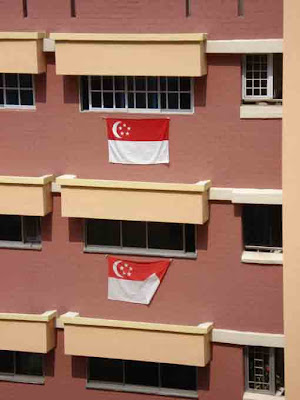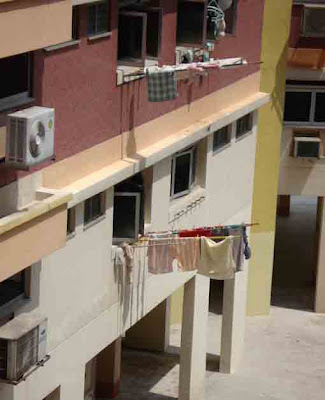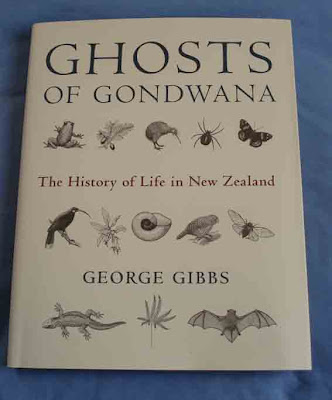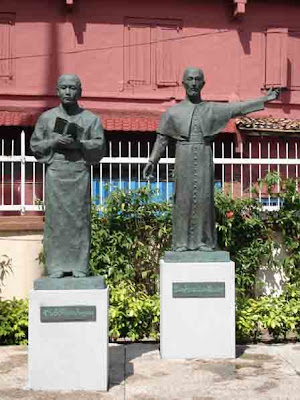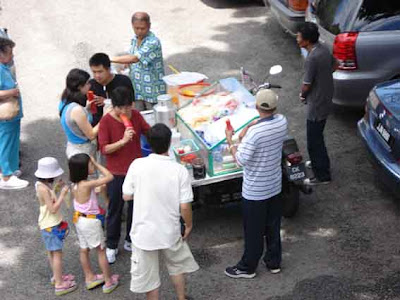Many Singaporeans are of Chinese racial origin and it is not hard to find temples ( though Christian churches are also quite common, and there are mosques as well.) The top two photos are of a temple downtown, and the Buddhist temple was not far from my friend's apartment.
Saturday, December 16, 2006
Singapore by Night
Singapore is the kind of place where you eat out every night. There are "food courts" all over the place. Some of them are more up-market and expensive, but many cater for locals and are quite cheap. As I was staying with a 'local" I got to sample food from many food courts.
One of the best I went to was also surprisingly cheap. It was located right by the harbour front near the theatre complex. These photos were all taken near there. The one with the two small wavy light-lines actually shows two of the harbour ferries. The blue lights were in a water feature near the theatre. (Singapore does 'water features' quite well, though they often feel 'planned' rather than 'exuberant' as in France.)
Singapore Apartment 2b
Some more photos from my friend's second apartment in Singapore.
People sometimes had their own individual touches on the landings outside their apartments. These orchids were part of a large 'potted garden' I always passed on the way back to my friend's apartment.
People sometimes had their own individual touches on the landings outside their apartments. These orchids were part of a large 'potted garden' I always passed on the way back to my friend's apartment.
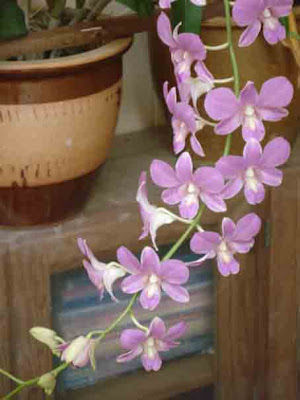
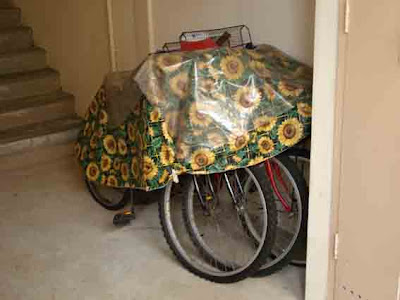
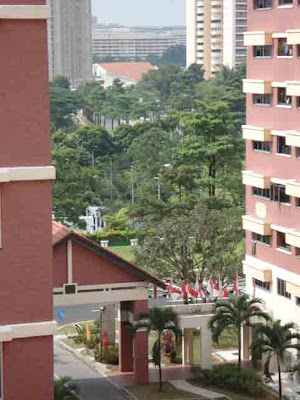
 It was Singapore National Day around the time I was there and there were lots of posters up urging people to fly the National flag. Not too many were flown in this particular block. I think it depended a bit on the politics you followed whether you did or didn't.
It was Singapore National Day around the time I was there and there were lots of posters up urging people to fly the National flag. Not too many were flown in this particular block. I think it depended a bit on the politics you followed whether you did or didn't.Singapore Apartment 2
I have a friend currently living in Singapore and I was able to stay with him in his apartment on my way both to and from Europe. He moved apartments while I was away and I took some 'alike but different' photos of his apartment blocks. Here are a few photos of his second block. Sometimes I just liked the patterns and shadows.
Singapore is largely made up of apartment blocks. They were surprisingly roomy inside and lots of elements of the design helped lend more of a 'community feel' than you might expect. A 'plus' was the low crime rate, so that as a woman I felt very safe coming back on my own to the apartment even at night-time.

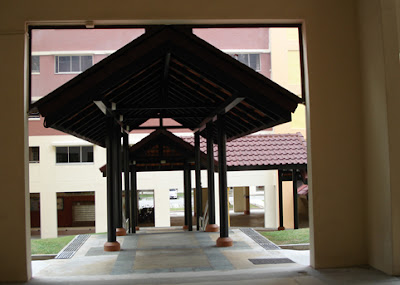 Covered walkways were incorporated, adding protection from the torrential downpours that could occur, and also adding some shade from the strong sunlight.
Covered walkways were incorporated, adding protection from the torrential downpours that could occur, and also adding some shade from the strong sunlight. This man is lighting an offering to the gods on a special feast day. These huge drums appeared and some people burnt many paper offerings.
This man is lighting an offering to the gods on a special feast day. These huge drums appeared and some people burnt many paper offerings.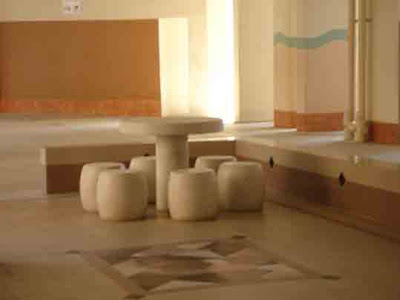 In the sheltered area at the bottom of the buildings many things happened. People often gathered to talk or play games around these tables. There were also study carousels where people could study. And sometimes part of the area was used for Buddhist funerals when someone in the block had died.
In the sheltered area at the bottom of the buildings many things happened. People often gathered to talk or play games around these tables. There were also study carousels where people could study. And sometimes part of the area was used for Buddhist funerals when someone in the block had died. Monday, December 11, 2006
Ghosts of Gondwana
Recently I went to my favourite bookshop to pick up a book I had ordered, and spied this one that I also came away with. It is wonderful! I haven't got too far into it yet, as I tend to fall asleep as soon as my head hits the pillow at this time of year, but what I have read so far has been fascinating.
The book answers a lot of the questions I have had about New Zealand's living things. How much of it has evolved from the times of Gondwana and our separation from the Australian landmass? Why is it we have so many different species that are not found elsewhere? It tells me many things I had not realised, eg our mosses are hardly endemic at all, but our flowering plants are 84% endemic; and our lizards and stream insects are 100% endemic. The book also lists interesting things like our 'absentees' ie groups that are present in Australia but which are missing in NZ. I am up to the section in the book where it discusses exactly what historical biogeography is, and how Darwin's ideas, plate tectonic theory, and now molecular biology, all influence how we have shaped our ideas of how life in New Zealand has evolved.
Last year I did a Massey paper on biological evolution and this book helps me fit some of those ideas into a practical context. In 2007 I plan to do a Massey paper on New Zealand fauna, and the book is giving me a chance to get a broad understanding of some new ideas I know I will study in more detail.
The author has a very clear writing style and the book is beautifully produced. I can't wait for my holidays (starting next week!) to read the whole book.
Saturday, December 09, 2006
Europe in Melaka
Strangely enough, in the east you sometimes find a little bit of Europe. Melaka has had quite a variable history in the last few hundred years because of its strategic position for shipping in the Malacca Straits. The Portuguese, the Dutch and the British all had a hand in it. (For more info about the Portuguese time here, try this website.)
 So in the historical district of Malacca you come across monuments you would not be surprised to see in Europe. The carving above was on the old fort. The church below came to be used by the British to store ammunition.
So in the historical district of Malacca you come across monuments you would not be surprised to see in Europe. The carving above was on the old fort. The church below came to be used by the British to store ammunition.  Tombstone in the old church.
Tombstone in the old church. This cage, still in the old church, covered the tomb of St Francis Xavier before it was moved to Goa in India.
This cage, still in the old church, covered the tomb of St Francis Xavier before it was moved to Goa in India.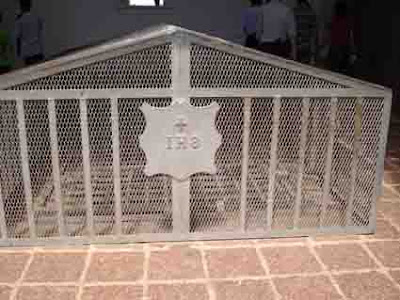 This is another statue to St Francis Xavier found in the grounds of the old church on the hill above the ruins of the old fort walls.
This is another statue to St Francis Xavier found in the grounds of the old church on the hill above the ruins of the old fort walls. 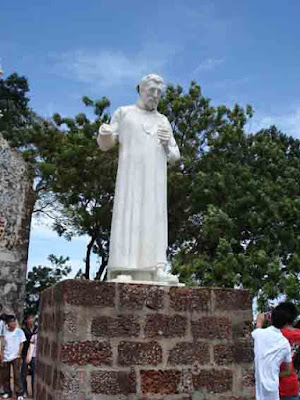
Chinatown, Melaka
These photos are not very good ones, but they show a little of the nature of Chinatown in Melaka. It is promoted very much for tourists, but many Malaysian tourists seem to be there so it still feels very 'local' and quite village-y ( especially compared to the much larger Chinatown in Singapore.)
From my balcony
From my balcony in Melaka I enjoyed watching the world go by. Down the street in this direction were many small Chinese-owned shops.
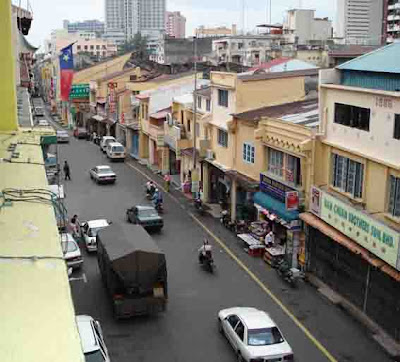
Looking from the balcony where the open-air basin was, I could see the canal, and over across to the church of Francis Xavier.
Melaka
Melaka was a touristy kind of place, but still managed to have quite a relaxed feel about it.
Here are some tourists enjoying some of the very colourful local transport. Everyone of these bicycle rickshaws ( for which I cannot recall the 'local' name) was a work of art in Melaka.
 This canal ran past my guesthouse. Despite the glossed up tourist buildings nearby, there was still evidence of the disparity of wealth in Malaysia.
This canal ran past my guesthouse. Despite the glossed up tourist buildings nearby, there was still evidence of the disparity of wealth in Malaysia. Some beautiful tropical flowers seen in the local museum complex.
Some beautiful tropical flowers seen in the local museum complex.Friday, December 01, 2006
Bosdet -stained glass
I was fortunate while in Jersey to notice a one-day tour run through the Tourist Office to look at the "Glass Rainbow." This tour was taken by 'Blue Badge' guide Paul Nicolle and looked at some of the windows in Jersey done by stained glass artist Henry Thomas Bosdet (1856 -1934).
Nicolle was a superb guide, and he covered so much in depth on the day. I was actually the only 'tourist' on the tour - everyone else was 'local'- so the day also provided an insight into island life through the locals I met. (And who made me feel very welcome.)
A lot of the stained glass originally in Jersey churches had been destroyed after the Reformation, but about the turn of the 20th century, ministers began to want to replace it. Bosdet was a Jersey-born artist who filled many commissions in various churches on the island.
 Paul Nicolle talked to us about how skilled Bosdet was at life drawing, and through the day we saw figures that seemed very life-like. Bosdet also used very brilliant colours, as can be seen in this window of the "sower".
Paul Nicolle talked to us about how skilled Bosdet was at life drawing, and through the day we saw figures that seemed very life-like. Bosdet also used very brilliant colours, as can be seen in this window of the "sower". Another characteristic of Bosdet's work was the brilliance of his angel's wings. The (lack of) sunlight did not really enable me to get a good shot of some of these wings.... but they were worth looking at on their own. You can see one example around this nativity scene.
Another characteristic of Bosdet's work was the brilliance of his angel's wings. The (lack of) sunlight did not really enable me to get a good shot of some of these wings.... but they were worth looking at on their own. You can see one example around this nativity scene. 
This Crucifixion scene was beautifully drawn and brought everyone to silent contemplation.
While in Ireland I saw a stained glass window that I feel sure must also have been a Bosdet commission. One day I will get organised and send Paul Nicolle a photo of it to see if he agrees.
Jersey
A major reason for going to Jersey was that Francis Davis Payn, my great-grandfather, was born there. After a few wrong turnings and a lot of help from a friendly meter-reader, I found "Les Ruettes", the house he was born in. This old well still sat in the garden on the property.
Subscribe to:
Posts (Atom)
